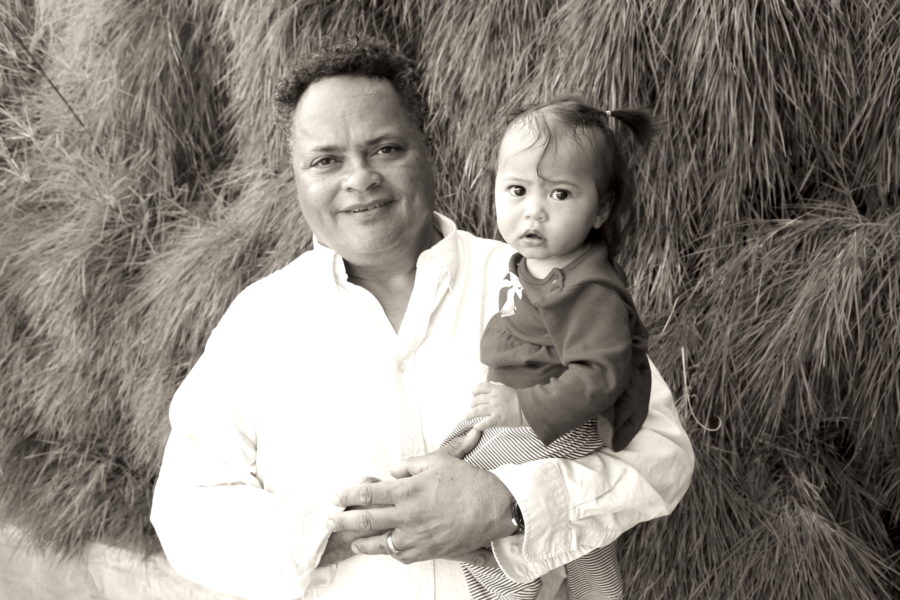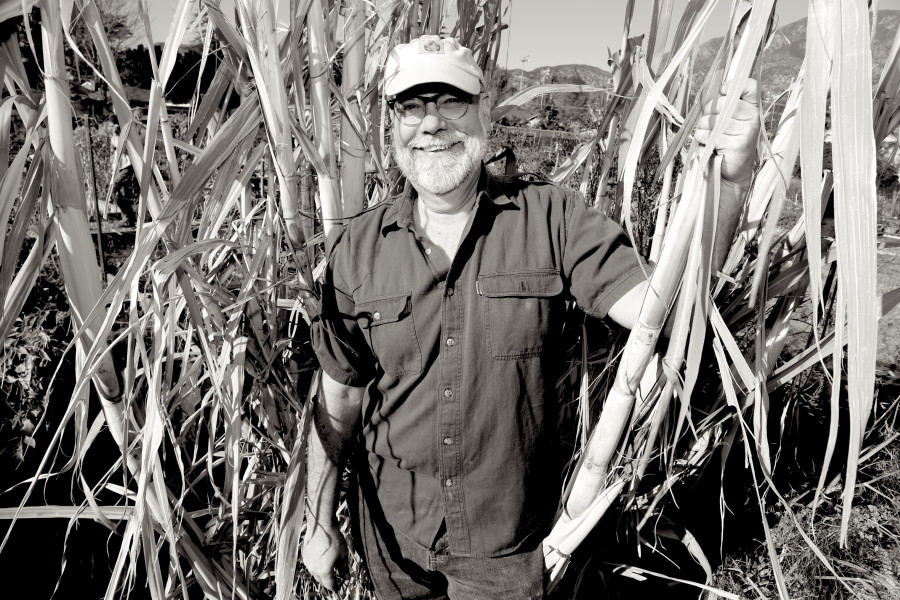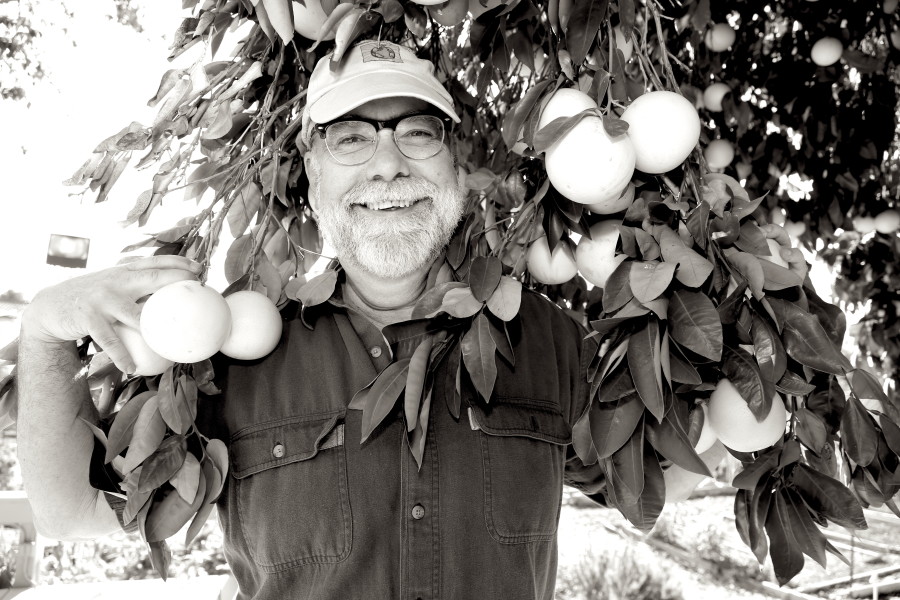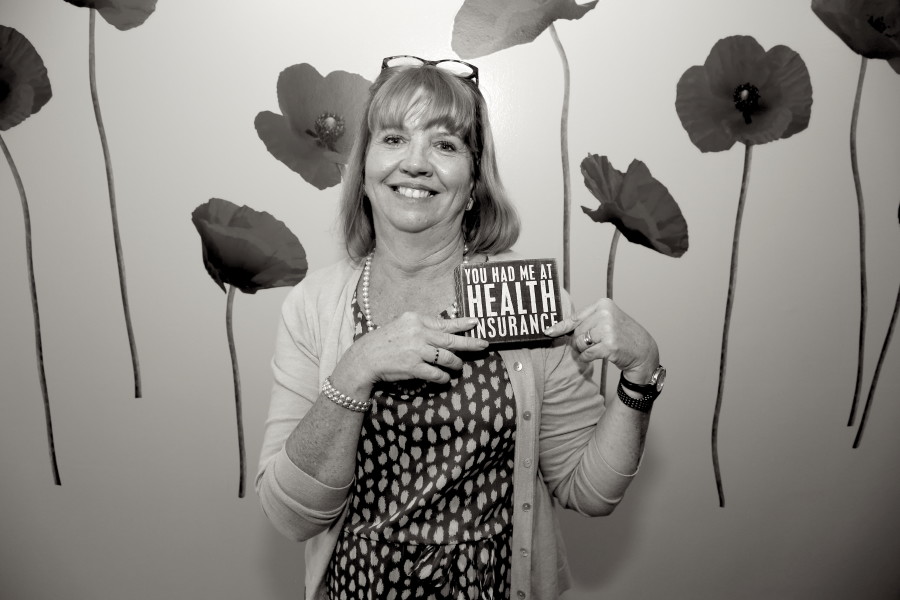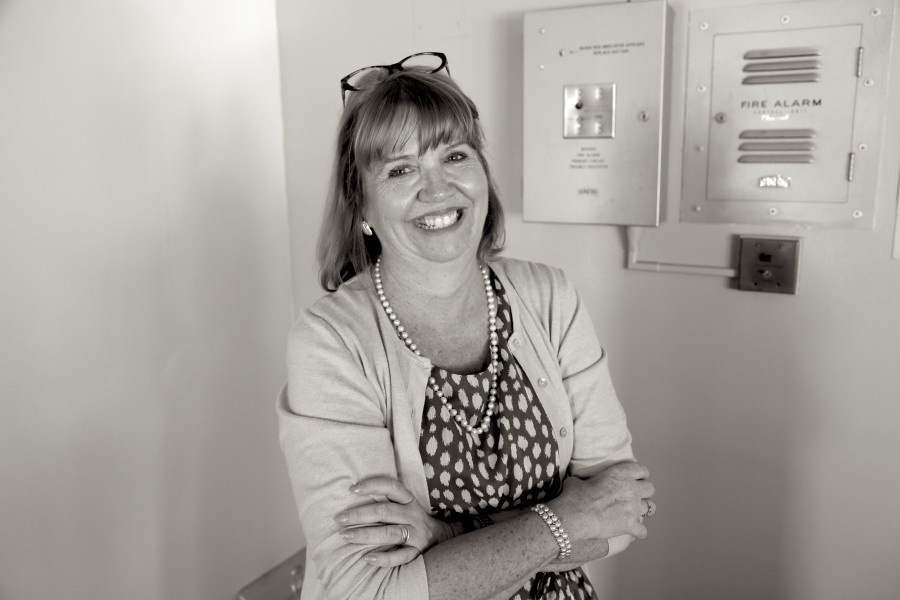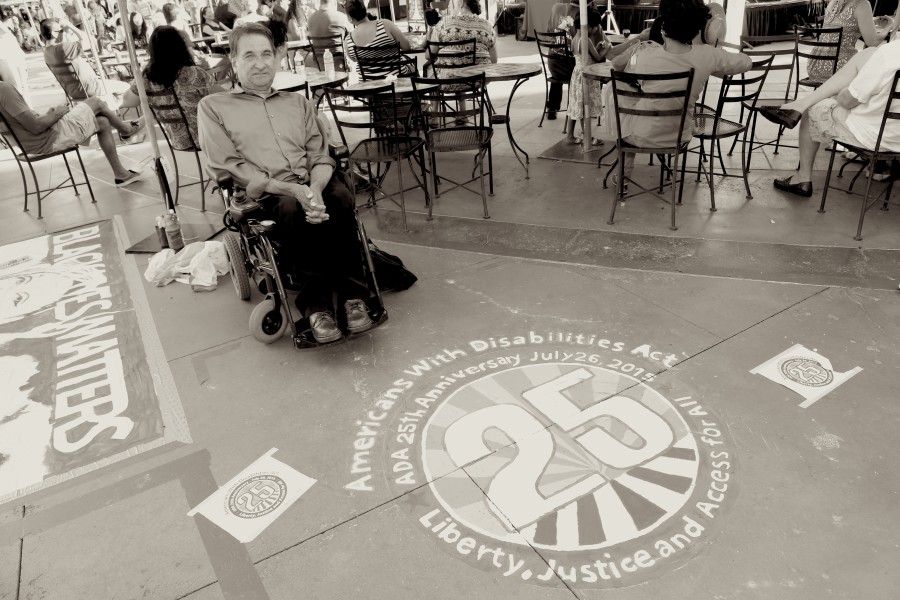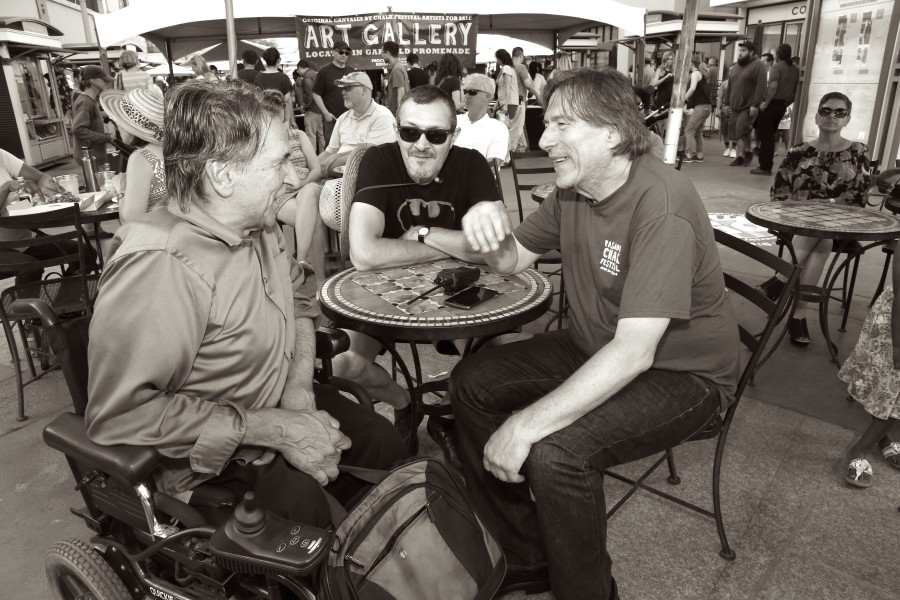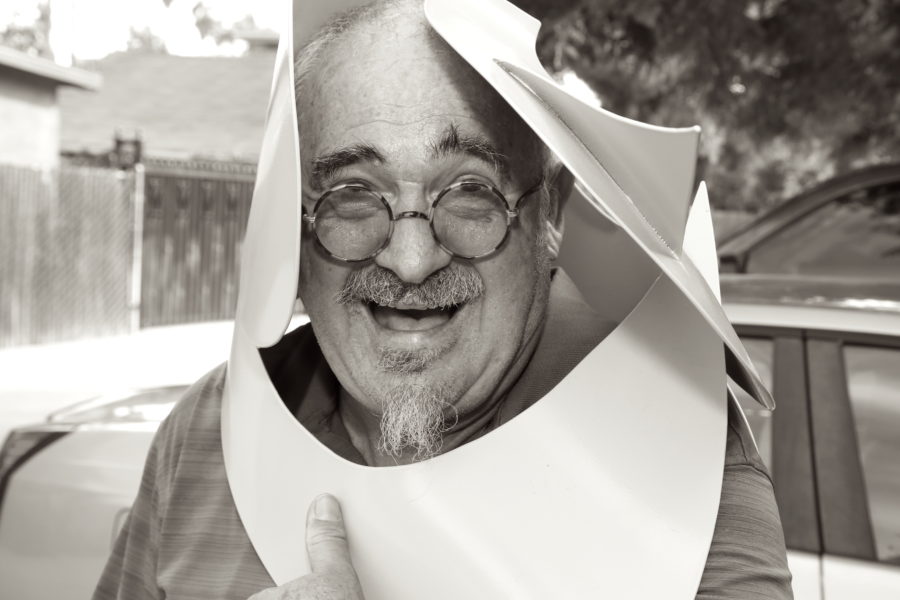
Luis Ituarte models one of his pieces of art at “La Linea Curva”.
citizen artist, statesman, catalyst, community organizer, culture identifier, humorist, basketball player
Luis Ituarte has had a storied career, one that has avoided traditional labels and one that is rooted in the notion that art should always have some sort of social benefit or impact. He has been a leader in cross-cultural art projects that emphasize collaboration and cooperation, rather than competition. And he professes that the real impact of the artistic experience is in the context in which it is created, rather than the object or the outcome. Luis continues to explore the range of artistic experiences with a variety of upcoming exciting interactive projects which you will learn about in this article.
Below you will find his thoughts about trying to survive as an artist to the value of international art projects to using art to “do good”. As a neighbor and a collaborator I have had the opportunity to cross paths with Luis regularly in recent months, so here are some of the highlights from those informative and inspiring conversations:
From your experience what is the value of art to society?
Art is a product of society and society projects itself through the arts.
Can you tell the story of playing basketball as a kid and how that experience shaped your world view?
In 1957 when I started middle school in Tijuana, Mexico, I was 14 years old. The most exciting thing for me about starting what you call junior high was playing basketball, the thing was that you have to be in a team by the first month of classes, (September). I was so eager to play and I asked over and over to be accepted into one team. Can I play? Can I play? I guess, that because I was so eager no one paid attention to me and I ended up not being in a team at the end of the month. I guess that if I had just sat and observed someone would ask, “Do you want to play with us?” But, I was so persistent in asking that nobody paid serious attention to me.
I panicked, so I concocted an idea. The school was out of town and a bus would pick us up at downtown, “C” street in front of a jewelry store, “Joyeria Inda” that also sold sporting goods. The owner, Mr. Inda, was a friend of my father. Mr. Inda’s store was the only one at the time that sold Wilson leather basketballs. I talked to him about buying one on installments and I paid $5 as a down payment. Mr. Inda, because he knew my family, suggested that I could take the ball with me. I said no. Because my plan was for him to put the ball in the window with a note that said “Reserved for Luis Ituarte.” He agreed. I talked to Mr. Inda on a Sunday and on Monday (first day of October) the ball with the sign was in the window, and by that Friday I had seven of the best players who wanted me to organize a team because we would be the only ones with a leather basketball. So I did.
We called our team “Pinguinos” (Penguins) because we were short, (some of us were not yet fully developed because of our age). I got sponsors to pay for T-shirts, organized a “Tardeada” (an afternoon dance), and got a trainer for the team (one of the top players from 3rd grade). Two weeks later we had our leather basketball and in March of the next year we played the finals against a team from the 3rd grade. We lost, but that was the first time that a team from 1st grade ever got to the finals. This experience marked me for the rest of my life. If you become familiar with my life story, you will find this pattern over and over again, my wanting to do something for me and end up doing something for others.
What is ‘alley art’ and how will it work in your neighborhood?
Alley Art is a gathering of Artists from Pasadena and Altadena who will meet at a “tailgate fashion” picnic to create and develop relationships while doing outdoor artwork, poetry readings and/or hangout doing diverse social activities in an environment supported mainly for the purpose of artists to relate and get to know each other and in this way create an urban public venue to strengthen enduring relationships and join a community of artists in search of an artistic identity for the region.
These events will be at Banbury Alley, (200 block, West Mountain Street between W. Mountain St. and Lincoln Ave. Pasadena CA. 91103), with the support of the Flintridge Center where I am the artist-in-residence. The prelude of this event will be on August 21, 2016 and will continue once a month in May, June, July and August 2017 (the third Sunday of the month).
Describe a ‘poly painting’ and its structure. What was the genesis of that project? How many have you created and where are they?
The purpose of Poly Painting is to create a visual history of a moment of a relationship.
Under the auspices of COFAC, I produced and directed groups of up to eight people each to create 6 x 20 ft. sized paintings (or murals) within the context of a happening in which food and music are part of the environment.
The experience that participants have is one of getting to know each other in the process of creating, in one day, something that they don’t normally do. This experience will produce a common history and the painting (mural) is a testimony and remembrance of that time. This experience validates my statement that “in art the value is in the context, not in the object.”
You participated in an international art project called ‘el túnel’ which featured an art museum on the border between San Diego and Tijuana. Please describe the impetus for the project and how it manifested itself. What has been its accomplishments? And what is its current status?
The building where La Casa del Túnel: Art Center is located was built in the 1950’s by Gabriel Moreno Lozano, a lawyer, Renaissance man and legendary figure of the City of Tijuana. In later years, a tenant of the building, without knowledge of the owner, dug a tunnel (approximately 150 ft.) under the house, across to a parking lot in the USA. and engaged in illegal activities. On July 8, 2004, the tunnel was discovered and most of the parties responsible were caught, arrested and imprisoned. Today, after three years of litigation, the owners, heir of Moreno Lozano, liberated the building and decided to provide a space for COFAC for the establishment of an international center for the arts. For more information www.cofac101.org/casa.htm As a result of an Annenberg Foundation grant to COFAC, we were able to retrofit the building (almost reconstructed) and finally, in 2008, we had the “official” opening.
Adolfo Nodal, Luis Ituarte and Gerda Govine Ituarte, co-founded “La Casa del Túnel: Art Center” which opened in 2008 in La Colonia Federal. The impetus was inspired by the following:
1. In 1996, “Bajo El Mismo Sol” (under the same sun) was born (by Adolfo Nodal, former General Manager of the Cultural Affairs Department of Los Angeles) and Luis Ituarte, Coordinator of International Affairs in the Department. I also commuted weekly between Los Angeles and Tijuana. The spirit of this program was not to compete with artists or putting the two cultures in competition, rather to emphasize relationships between artists and administrators.
2. In 2003, Consejo Fronterizo de Arte y Cultura, (COFAC) a 501c(3) the brain child of Luis, was formed in Los Angeles and subsequently became an Asociacion Civil (Mexican non-profit) in 2009 in Tijuana. Prior to this time, Luis met over a three-year period (1995-1998) with a group of artists, cultural promoters, journalist, and filmmakers from Tijuana B.C., Mexico and Los Angeles. Prior to COFAC’s non-profit status as a 501 (c) 3 on July 28, 2003, numerous activities were organized. From 1996-2003 all of the activities of COFAC was presented under the umbrella of a project named “Bajo el Mismo Sol,” which was sponsored by the Cultural Affairs Department of the City of Los Angeles and the Instituto Municipal de Arte y Cultura de Tijuana. Under the umbrella of this project more than 50 activities were presented in both cities, for example, “Poetas Por Pintores” (Poets for Painters), a two-year exchange program in which poets in Tijuana were performing in Los Angeles and painters from Los Angeles were exhibiting in Tijuana in 1996. The next year, 1997 painters from Tijuana were exhibiting in Los Angeles and poets from Los Angeles were performing in Tijuana.
3. “La Casa del Túnel: Art Center” was opened under our leadership from 2008-2011 with an international (Los Angeles and San Diego County and Tijuana) board chaired by Al Nodal as Gerda and I lived in both Pasadena and Tijuana. La Casa received funding from the U.S. and Mexico. In 2012, the operation of the Center was turned over to The World Beat Center, a non-profit organization in San Diego. However, we continue to be involved in the arts and culture scene of the “mega metropolis” of Los Angeles County, San Diego County and Tijuana.
The above is a brief snapshot. “La Casa del Túnel: Art Center” is an international bridge that garnered world-wide coverage and support. Our fingerprints are on the soul of the arts and culture scene in Tijuana and we continue to maintain our friendships and relationships.
COFAC, a 501( 3 ) art and culture non-profit has had many events sponsored by the City of Pasadena Cultural Affairs Division, “Cool Succulent Mural,” ArtNight, bringing La Ballena de Jonas, a band from Tijuana to Pasadena, and two other performance groups during ArtNight. As of July 2016, COFAC is the sponsor of “Poetry Within Reach” (Gerda is Producer/MC)) as a result of an NEA grant to the City of Pasadena Cultural Affairs and partner Side Street Projects. This four-week event recognizes nine published Pasadena poets, known as the Pasadena Rose Poets. In addition, COFAC, has organized another group of poets to read at Lit Crawl LA NoHo event on October 26, 2016. We continue our amazing and interesting journey as we stay involved and give back without reservation to bridge borders and stay on course finding and creating art and cultural involvement outside lines of demarcation. Among many things, Luis is a Citizen Artist and Gerda is a Citizen Poet.
You have worked with artists all over the world, particularly in Latin America. What was the recent event you attended in Cuba and what were it’s the outcomes? With improvements in relations between these countries what new opportunities are there for collaboration between Cuban and U.S. artists?
In 2014 I assembled a group of artist friends (one from U.S., one from Canada and one from Mexico) who were experimenting with “noise” (sound improvisations) with the intent of producing memories that interact with the audience. We called the group Noema. (no-poem). The focus of this group was the promotion, documentation and publication of “sound” pieces. This experimental group concentrated on impacting the audience in creating memories provoked by the sounds they hear. We ask the audience to share their experience at the end of the performance.
We were recommended to and subsequently invited by the organizing committee of the Cuban Biennale to perform during the event in 2013. For more information go to: www.noema.mx. In my experience, and with the new developments of curing the relationship between the U.S. and Cuba, the opportunities for artists in the United States are great because due to the restrictions of the embargo and the scarcity of art materials. Cuban artists are amazing in using what is available, namely, found objects or producing their own art materials basic resources. This is inspiring for us who are accustomed to going to the art store and getting what we need.
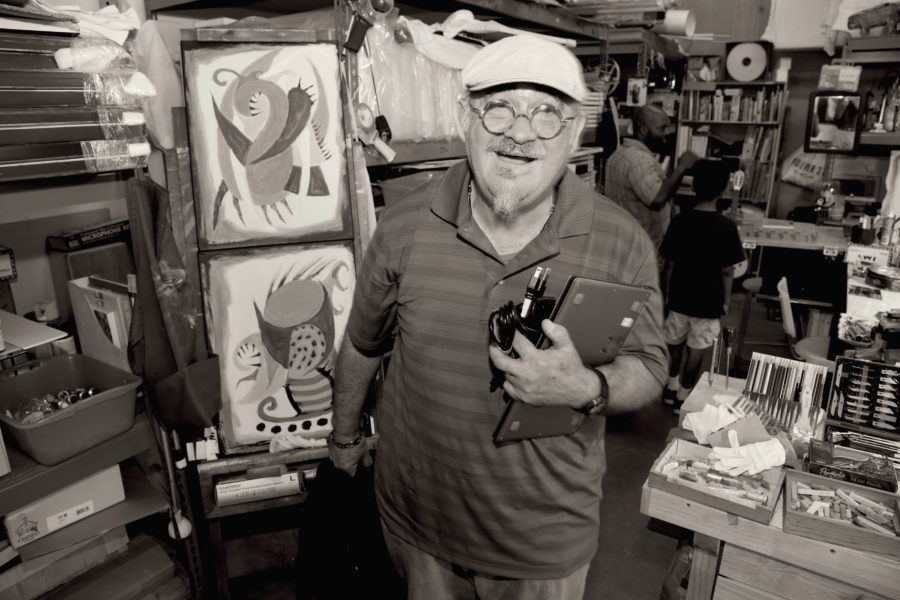
Artist in Residence
For centuries the artist’s challenge has been how to create art and simultaneously feed him/herself. How have you managed to stay prolific over the years and pay your bills?
Basically there are two kinds of artists, the ones who are born artists and the ones who make themselves artists. I think I belong to the second category and somehow I have been able to get myself employment in the cultural arena, which has given me the opportunity to sustain myself as an artist. Art is an activity that requires investment of time and money. And, depending sometimes, some artists have more ability to nourish their art than others. Somehow that is reflected in the end product. Basically, I have been just lucky.
Where do you find inspiration for your artistic endeavors?
In the relationships that I have with people and the environment that surrounds me and my obsession to create some good.
What types of public art projects have you been involved with over the years and what are you most proud of?
I have been involved in many public art projects since 1972 in three countries (Mexico, Canada and U.S. The following are the most important public art events in which I have been involved in this region, Pasadena, Los Angeles, San Diego and Tijuana).
- Mural, “Todos Los Ninos Son Tuyos (All the Children are Yours), East Los Angeles, CA, 1991.
- Team member, (semi-finalist), Martin Luther King Memorial Project, Cal Trans/City of San Diego Arts and Culture Commission, San Diego, California, 2006.
- “Poly Painting” Murals, 1.- Boys and Girls Club of Pasadena, 2.- Scott McKenzie Child Care Center, 3.- Flintridge Foundation, 4.- Art Center College of Design, 5.- Art Walk Pasadena and Artist Group 2007-2009.
- Created the non profit Consejo Fronterizo de Arte y Cultura (COFAC)/Border Council of Arts and Culture, Pasadena, CA, 2003
- “Cool Succulents” Mural Project, Individual Artist Grant, City of Pasadena Cultural Affairs Department, (Digital mural on weather resistant plastic installed on exterior wall of Pasadena Fish Market Restaurant) Orange Grove Boulevard, Pasadena, California, 2009.
- Project Director, Casas Arte Home Intervention Project, National Association of Latino Arts and Culture, Tijuana, Mexico and Highland Park, CA, 2009-2011.
- Co-participant, Performing Public Space, Economy of Gesture (human directional spinning) “Lo Que Resiste Persiste,” Downtown Los Angeles, CA, 2010.
- Curator/Producer, Community Beautification Project: 32 barrels of fruit trees distributed to community in Colonia Federal, Tijuana, Mexico in collaboration with the Fallen Fruit Group, Los Angeles, CA. 2009.
I am most proud of the work done in Tijuana, as Co-founder, Developer and Curator of La Casa del Túnel: Art Center right on the border between Mexico and San Diego.
It appears as though you are as creative as ever with multiple projects being conjured up in your mind simultaneously. So what ideas do you have for upcoming programs; projects, exhibits, and
collaborations?
I am very excited about a project called “Alley Art.” (See answer above).
Also, I am supporting my poet wife, Gerda Govine Ituarte’s endeavors in helping to publish her books, create the art work vignettes, travel with her here and overseas, and, presently, with her new amazing project, “Poetry Within Reach” with the Pasadena Rose Poets comprised of Pasadena-based poets with an emphasis on civic participation. I am planning a conference of artist couples from Tijuana, San Diego and Los Angeles (Pasadena) sharing their experiences about the creative process and how they manage to survive.
This fall I begin a three-month residency, September through November, in Cleveland sponsored by the Cleveland Foundation/Creative Fusion Residencies to participate in the “Ingenuity Fest” September 23-25 in Saint Clair Superior, create a Poly Painting and help organize a “El Dia de Los Muertos” Festival (Day of the Dead).
And this is my second year as the Artist-in-Residency at the Flintridge Center.
Generally we perceive artists to be solo practitioners locked away in an isolated studio painstakingly creating art hour by hour alone. However, much of your art has been developed in a collaborative space where others are contributing to the creative process with you. What is it about working with others that is so powerful and fulfilling to you?
As much as I love spending some time alone in my studio, I am always concocting ways to come out of it. I believe it is part of my nature and that has allowed other people to perceive me as a “Citizen Artist,” of which I am very proud because that allows me to create a dimension between the abstraction of my painting and the reality of life. I collaborate with artisans and other artists to fulfill that inter-dimension that makes me somewhat unique.
Do you have any suggestions for other artists, especially young ones, on how to practice your art and not compromise your values?
You could be an artist by not compromising your values. This means that you have to be genuine in what you do and try to reflect yourself in what you do in your art. I don’t like to patronize young artists by telling them what to do. Art is not a profession; it is a way of life. You should do what you have to do to survive in that life.
